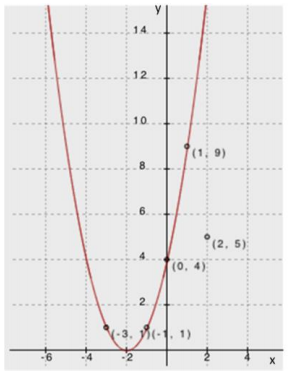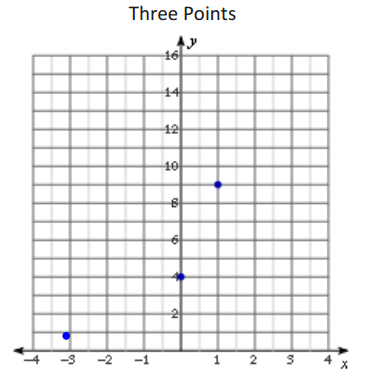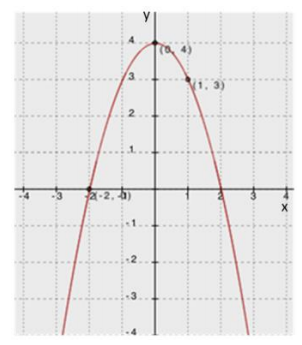Engage NY Eureka Math Algebra 1 Module 4 Lesson 24 Answer Key
Eureka Math Algebra 1 Module 4 Lesson 24 Example Answer Key
Example 1.
Use the points (0, 4), (1, 9), and (-3, 1) to write the equation for the quadratic function whose graph contains the three points.
Answer:
Demonstrate for students how, if we know the y-intercept and two other points for a quadratic function, we can form a system of linear equations to determine the standard form of the quadratic function defined by those points. Use the example with the blue points above: (0, 4), (1, 9), and (-3, 1).
Notice that we have the y-intercept, which allows us to find the value of c quickly and first. After that, we can substitute the other two coordinates into the equation, giving us two linear equations to solve simultaneously.
Using (0, 4)
f(x) = ax2 + bx + c
4 = a(0)2 + b(0) + c
4 = c
Using (1, 9)
f(x) = ax2 + bx + 4
9 = a(1)2 + b(1) + 4
9 = a + b + 4
a + b = 5
Using (-3, 1)
f(x) = ax2 + bx + 4
1 = a(-3)2 + b(-3) + 4
1 = 9a-3b + 4
9a-3b = -3
→ Since c = 4, the resulting system has two variables:  . Use substitution or elimination to determine that a = 1 and b = 4.
. Use substitution or elimination to determine that a = 1 and b = 4.
→Substitute a = 1, b = 4, and c = 4 into standard form: f(x) = x2 + 4x + 4 is the quadratic function that contains the given points.
Demonstrate that the graph of the function we just found does, in fact, pass through all three points by showing the graph on the board or screen.
→ Notice that in the graph below, we have included the two different fourth points from the Opening Exercise, (-1, 1) and (2, 5). Clearly (-1, 1) is on the graph of the function, but (2, 5) is not.

Eureka Math Algebra 1 Module 4 Lesson 24 Exercise Answer Key
Opening Exercise
Draw as many quadratic graphs as possible through the following two points on the graph. Check with your neighbors for ideas. These points are (0, 4) and (1, 9).

Answer:
After a few minutes, gather the class together, and have students share some of their graphs. You might have three or four students come to the board and sketch one of their graphs, each in a different color. There are an infinite number of solutions. Make sure that some of the sketches have one of the points as a vertex and that some open up and some down.
Now, introduce a third point and ask students to repeat the exercise. Now the points are (0, 4), (1, 9), and (-3, 1).

Ultimately, students should conclude that only one quadratic graph can pass through all three points simultaneously. Therefore, it requires no less than three points to determine a quadratic function.
Students may be curious about what happens if a fourth point is introduced. Add a fourth point in two different places, and have them study the possibilities. Try adding a point in another color that is on the quadratic graph, (-1, 1), and then add one that is not, (2, 5).


Explain that a fourth point, in this case (2, 5), may either belong to the quadratic graph (see: Fourth Point #1 graph) or not (see: Fourth Point #2 graph), but the function has already been determined by the first three (blue) points.
Exercise 1.
Write in standard form the quadratic function defined by the points (0, 5), (5, 0), and (3, -4).
Answer:
Using (0, 5)
f(x) = ax2 + bx + c
5 = a(0)2 + b(0) + c
5 = c
Using (5, 0)
f(x) = ax2 + bx + 5
0 = a(5)2 + b(5) + 5
0 = 25a + 5b + 5
25a + 5b = -5
5a + b = -1
Using (3, -4)
f(x) = ax2 + bx + 5
-4 = a(3)2 + b(3) + 5
-4 = 9a + 3b + 5
9a + 3b = -9
3a + b = -3
Since c = 5, the resulting system has two variables:  .
.
Use substitution or elimination, and find that a = 1 and b = -6.
Substitute a = 1, b = -6, and c = 5 into standard form: f(x) = x2-6x + 5 is the quadratic function that contains the given points.
Exercise 2.
Louis dropped a watermelon from the roof of a tall building. As it was falling, Amanda and Martin were on the ground with a stopwatch. As Amanda called the seconds, Martin recorded the floor the watermelon was passing. They then measured the number of feet per floor and put the collected data into this table. Write a quadratic function to model the following table of data relating the height of the watermelon (distance in feet from the ground) to the number of seconds that had passed.

a. How do we know this data will be represented by a quadratic function?
Answer:
The relationship between height and time for all free-falling objects is represented by a quadratic equation. Also, we can see mathematically that the function values have a first difference of -16, -48, -80, and -112. The second differences are constant at -32.
b. Do we need to use all five data points to write the equation?
Answer:
No, only three are needed.
c. Are there any points that are particularly useful? Does it matter which we use? Write the quadratic function that models the data.
Answer:
(0, 300) is useful because it is the y-intercept. We will need to use (0, 300), but the other two can be selected based on efficiency (the least messy or smallest numbers).
Use (0, 300)
f(t) = at2 + bt + c
300 = a(0)2 + b(0) + c
300 = c
Use (1, 284)
f(t) = at2 + bt + c
284 = a(1)2 + b(1) + 300
-16 = a + b
Use (2, 236)
f(t) = at2 + bt + c
236 = a(2)2 + b(2) + 300
-64 = 4a + 2b
Since c = 300, the resulting system has two variables:  .
.
Use substitution or elimination and find that a = -16 and b = 0.
Substitute a = -16, b = 0, and c = 300 into standard form: f(t) = -16t2 + 300.
d. How does this equation for the function match up with what you learned about physics in Lesson 23? Is there a more efficient way to find this equation?
Answer:
It matches perfectly. This equation shows that the initial position (height) of the object is 300 ft. and that the initial velocity is 0. It correctly uses -16 as the leading coefficient. We could have written the equation directly from the information provided since we already know the initial height and velocity.
e. Can you use your quadratic function to predict at what time, t, the watermelon will hit the ground (i.e., f(t) = 0)?
Answer:
Yes.
f(t) = -16t2 + 300
0 = -16t2 + 300
-300 = -16t2
18.75 = t2
±4.33 ≈ t
So, the watermelon hit the ground after about 4.33 sec.
Eureka Math Algebra 1 Module 4 Lesson 24 Problem Set Answer Key
Question 1.
Write a quadratic function to fit the following points, and state the x-values for both roots. Then, sketch the graph to show that the equation includes the three points.

Answer:

Using the three points:
Use (0, 4)
f(x) = ax2 + bx + c
4 = a(0)2 + b(0) + c
4 = c
Use (-2, 0)
f(x) = ax2 + bx + c
0 = a(-2)2 + b(-2) + 4
-4 = 4a-2b
Use (1, 3)
f(x) = ax2 + bx + c
3 = a(1)2 + b(1) + 4
-1 = a + b
Since c = 4, the resulting system has two variables: ![]() .
.
Use substitution or elimination and find that a = -1 and b = 0.
Substitute a = -1, b = 0, and c = 4 into standard form: f(x) = -x2 + 4.
Question 2.
Write a quadratic function to fit the following points: (0, 0.175), (20, 3.575), (30, 4.675).
Answer:
Use (0, 0.175)
f(x) = ax2 + bx + c
0.175 = a(0)2 + b(0) + c
0.175 = c
Use (20, 3.575)
f(x) = ax2 + bx + c
3.575 = a(20)2 + b(20) + 0.175
3.4 = 400a + 20b
Use (30, 4.675)
f(x) = ax2 + bx + c
4.675 = a(30)2 + b(30) + 0.175
4.5 = 900a + 30b
Since c = 0.175, the resulting system has two variables: ![]() .
.
Use substitution or elimination and find that a = -0.002 and b = 0.21.
Substitute a = -0.002, b = 0.21, and c = 0.175 into standard form: f(x) = -0.002x2 + 0.21x + 0.175.
Eureka Math Algebra 1 Module 4 Lesson 24 Exit Ticket Answer Key
Question 1.
Write a quadratic function from the following table of data.

Answer:
Using the three points:
Use (0, 4.7)
f(x) = ax2 + bx + c
4.7 = a(0)2 + b(0) + c
4.7 = c
Use (100, 8.7)
f(x) = ax2 + bx + c
8.7 = a(100)2 + b(100) + 4.7
4 = 10, 000a + 100b
Use (200, 10.7)
f(x) = ax2 + bx + c
10.7 = a(200)2 + b(200) + 4.7
6 = 40, 000a + 200b
Since c = 4.7, the resulting system has two variables:  .
.
Use substitution or elimination and find that a = \(\frac{-1}{10, 000}\) = -0.0001 and b = \(\frac{1}{20}\) = 0.05.
Substitute a = -0.0001, b = 0.05, and c = 4.7 into standard form: f(x) = -0.0001x2 + 0.05x + 4.7.